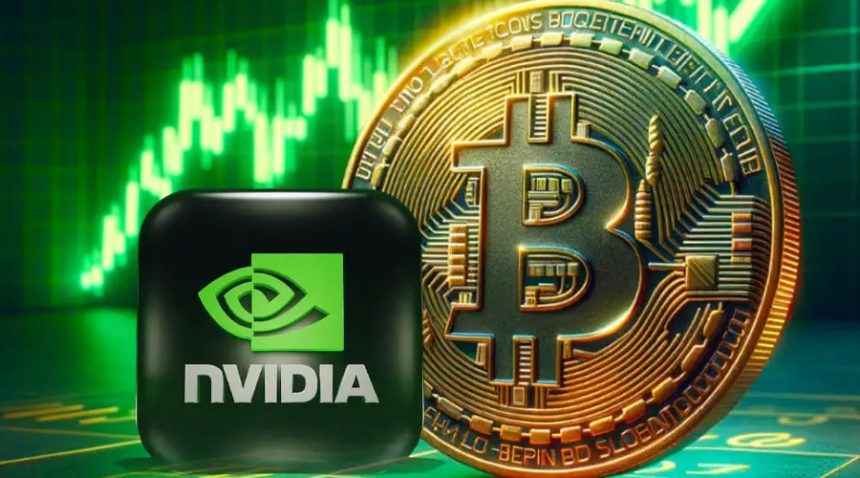Which asset will dominate this year—NVIDIA’s cutting-edge AI advancements or Bitcoin’s unstoppable crypto surge?
NVIDIA Corporation (NVDA) and Bitcoin (BTC) have emerged as prominent investment options, each offering unique opportunities and risks. As of March 10, 2025, NVIDIA stock is trading at $106.98, reflecting a 5.1% decline from the previous close. Bitcoin is priced at $79,607, marking a 3.057% decrease over the same period. This analysis compares these two assets, examining their recent performances, influencing factors, and future prospects to determine which investment may reign supreme in 2025.
NVIDIA Corporation: Recent Performance and Influencing Factors
NVIDIA has experienced notable volatility in recent months. The stock reached a record high in early January but has since declined by approximately 30%. This downturn has brought NVIDIA’s trailing 12-month price-to-earnings (P/E) ratio to 36.4, the lowest level since before the launch of ChatGPT in November 2022. Despite this correction, NVIDIA’s forward P/E ratio stands at 24, indicating a 41% reduction from its valuation at the time of ChatGPT’s release.
Several factors have contributed to this decline:
Tariff Policies: President Donald Trump’s announcement of new tariffs on imports from Canada, Mexico, and China has raised concerns about increased costs for companies like NVIDIA, leading to stock price declines.
Regulatory and Geopolitical Uncertainties: Potential export restrictions on chips to China pose significant revenue risks for NVIDIA, as the Chinese market represents a substantial portion of its sales.
Sector-Wide Pressures: The semiconductor industry faces challenges due to potential tariffs, regulations, and innovations that could lower computing costs, impacting companies like NVIDIA.
Future Outlook for NVIDIA
Analysts maintain a cautiously optimistic outlook for NVIDIA. Ben Reitzes of Melius Research has a “Buy” rating on the stock but has reduced his two-year price target from $195 to $170, citing ongoing uncertainties. The upcoming GPU Technology Conference (GTC), where CEO Jensen Huang is expected to present NVIDIA’s innovation roadmap, could serve as a positive catalyst for the stock.
Bitcoin: Recent Performance and Influencing Factors
Bitcoin has also experienced significant fluctuations. In February 2025, it recorded a 17.5% decline, marking its most substantial monthly loss since June 2022. This drop pushed Bitcoin into a bear market, falling over 20% from its mid-January peak of $109,071 to end February at approximately $84,252.
Key factors influencing Bitcoin’s recent performance include:
Market Volatility and Trade War Fears: Rising market volatility and concerns about a global trade war, sparked by President Trump’s new tariffs, have negatively impacted Bitcoin’s value.
Cybersecurity Issues: A large-scale cyber-attack on the Bybit exchange, resulting in the theft of $1.5 billion in digital assets, has further dampened market sentiment.
Government Initiatives: President Trump’s announcement of a U.S. strategic crypto reserve, including Bitcoin, led to a temporary price rally, with Bitcoin briefly bouncing back to $94,000 following the news.
Future Outlook for Bitcoin
Analysts have varied predictions for Bitcoin’s future:
H.C. Wainwright projects Bitcoin reaching $225,000 by the end of 2025, driven by historical price cycles, favorable regulatory expectations under the Trump administration, and increased institutional adoption.
Bernstein predicts Bitcoin could hit $200,000 by 2025, citing strong inflows into spot U.S. Bitcoin ETFs and anticipated approvals at major financial platforms.
The Stock-to-Flow model suggests Bitcoin’s price could trade between $65,000 and $524,000 in the four years following the 2024 halving, reflecting the cryptocurrency’s historical volatility.
Comparative Analysis: NVIDIA vs. Bitcoin
When comparing NVIDIA and Bitcoin as investment options for 2025, several factors should be considered:
Volatility: Both assets exhibit high volatility. NVIDIA’s stock has experienced a 30% decline from its peak, while Bitcoin saw a 17.5% drop in February 2025 alone.
Market Influences: NVIDIA is affected by industry-specific factors such as semiconductor demand, supply chain issues, and geopolitical events. Bitcoin’s value is influenced by broader economic indicators, regulatory developments, and technological advancements.
Growth Potential: Analysts project significant growth for both assets. NVIDIA’s advancements in AI and GPU technology position it well for future growth, while Bitcoin’s increasing institutional adoption and potential regulatory support could drive its value higher.
Risk Factors: NVIDIA faces risks related to trade policies and competition within the semiconductor industry. Bitcoin’s risks include regulatory uncertainties, cybersecurity threats, and market manipulation concerns.
Both NVIDIA and Bitcoin present compelling investment opportunities for 2025, each with distinct characteristics and risk profiles. NVIDIA offers exposure to the burgeoning AI and semiconductor sectors, with potential growth driven by technological innovations and increasing demand. Bitcoin provides an avenue into the evolving digital asset space, with prospects bolstered by institutional adoption and potential regulatory support.
Investors should carefully assess their risk tolerance, investment goals, and market outlook when considering these two options. The final decision will depend on individual financial objectives and the willingness to navigate the inherent volatility associated with both investments.






